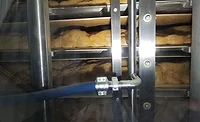Blockchain
Using blockchain to track transparently
Blockchain technology can create trust within a competitive environment, enabling collaboration and connection

Blockchain-based supply chain management systems allow for transparency, traceability and verifiable data.
Source: Getty Images

With blockchain-based supply management systems, processors can track ingredients from the farm all the way through the production process.
Source: Getty Images
Global supply chains can be challenging to track and trace as paper trails can be difficult to follow, and they do not offer transparency.
Additionally, there is a chance that those who adjust specific details of orders could manipulate them. With the FDA’s November 2020 proposal to establish additional traceability recordkeeping requirements (beyond what is already required in existing regulations) for those who manufacture, process, pack or hold foods that the agency has designated for inclusion on the Food Traceability List, a transparent supply chain is more important than ever. The rule, referred to as the Food Traceability proposed rule, is a key component of the FDA’s New Era of Smarter Food Safety Blueprint and would implement Section 204(d) of the FDA Food Safety Modernization Act (FSMA). Supply chain traceability is a strong use case for blockchain in the food and beverage segment. Blockchain technology creates a linear, open traceability on food products—one which cannot be altered.
“Track and trace is often a challenge for today’s supply chains due to outdated paper processes and disjointed data systems that slow down communication,” says Herain Oberoi, GM of database, analytics, and blockchain marketing at Amazon Web Services (AWS). “The lack of data compatibility exposes supply chains to problems like visibility gaps, inaccurate supply and demand predictions, manual errors, counterfeiting and compliance violations.”
He says this is where blockchain can allow organizations to gain real-time, end-to-end visibility into their supply chains. Transactions are always time-stamped and up to date, so companies can query a product’s status and location at any point in time.
Paul Chang, global blockchain industry leader—distribution and industrial sectors at IBM, agrees. IBM is the creator of IBM Food Trust, an ecosystem of producers, suppliers, manufacturers, retailers and others creating a smarter, safer, more sustainable food system for all.
“By tracing food in this way, we unlock a number of benefits,” says Chang. “You can quickly determine the origins and causes of spoilage by being able to identify precisely where in the supply chain something went wrong. You can show provenance, proving that certain methods, raw materials or traditions were used or that goods were produced in a specific place. You can make recalls targeted and adjust production to meet demand, both of which reduce food waste and make the food system more sustainable.”
By facilitating information exchange and collaboration, Chang says they can also make supply chains more proactive, because information about what is happening in grocery stores will not take days or weeks to reach the manufacturers, producers and suppliers who work with them.
Oberoi adds that blockchain helps to combat issues like counterfeit goods, compliance violations, delays and waste.
“In addition, immediate action can be taken during emergencies (e.g., in the case of product recalls), and regulatory compliance is ensured by the ledger audit trail,” he says. “Companies can also choose to share track-and-trace data with their customers as a way to verify product authenticity and ethical supply chain practices.”
This is exactly what Nestlé Australia Ltd., an AWS customer, uses blockchain for with its Chain of Origin coffee brand. Armin Nehzat, digital technology manager at Nestlé Australia Ltd., says the following characteristics of blockchain help to ensure they deliver on their mission:
- Transparent: Members on the blockchain network can see everyone’s activities. This ensures everyone is held accountable to their deliverables.
- Verifiable: As the product moves across the supply chain, participants can verify each other’s activities and raise alarms when needed.
- Immutable: Once an update is made on the network, it cannot be changed. This means that users can always go back and audit activities to detect anomalies and learn from their mistakes.
“The combination of these blockchain characteristics is what helps us better collaborate with our suppliers and ultimately connect consumers with the provenance of their products,” Nehzat says.
What to Know
Just what do processors need to know as they test drive this technology? IBM’s Chang says that food processors have a lot more options than they did even a year or two ago.
“In blockchain’s earlier days,” he says, “if you wanted to begin using blockchain in a targeted, specific and helpful way, there was a good chance you needed to create a network of your own, which is hard for a small- or medium-sized player.”
Creating a blockchain network is a relatively simple technological lift, but the process is still demanding due to the need to create a governance structure and rules for how you and your network partners are going to work together, he says.
“Fast-forward to today, however, and there are numerous, enterprise grade blockchain networks in production that organizations of any size can simply join, from IBM Food Trust to more industry-specific networks for products like seafood and coffee. This makes the process for adopting blockchain and realize the benefits much more rapid than it was,” Chang says.
Oberoi add that processors should identify specific processes and scenarios where blockchain can be helpful, and start with a proof-of-concept implementation based on one of these use cases.
“Supply chains are often complex,” he says. “Processors should also identify and select a few members for participation in the proof-of-concept and try to simulate an environment as close to the real-world as possible.”
He also says that before embarking on the project, ensure clarity about whether the use case requires “centralized ownership” of the ledger for tracking and tracing, or “decentralized ownership,” where multiple parties can transact with one another without having to know or trust each other. “Scenarios that require ‘decentralized ownership’ will benefit the most from using blockchain as the underlying technology,” Oberoi says.
When asked what types of facilities in the food space can benefit most from blockchain technology, Chang explains that IBM Food Trust is an industry-wide solution meant to benefit all participants. He says retailers can make sure they are selling the freshest foods possible while wholesalers and distributors can keep an eye on inventory and demand up and down the supply chain to make sure goods move appropriately.
“However, many interesting uses of blockchain happen early in the supply chain with food producers like processers and farmers,” he says. “We have food producer clients like Kvoray who use blockchain to monitor their fish farms tracking data such as when the fish were born, when and what they were fed, when they were harvested and what temperature they were when they were shipped. Similarly, olive oil producers like Terra Delyssa use blockchain to track the olives through each stage of olive oil processing to ensure it meets international standards of quality. In 2020 alone, four major olive oil companies across the supply chain began using IBM Food Trust. “
Oberoi says blockchain can help improve business processes across all types of facilities. “Anytime there are reconciliation challenges or limited visibility into the movement of goods, there’s a role for blockchain. However, we are seeing special interest from the packaged goods industry, with customers dealing with coffee, chocolate and baby food,” he says.

“The discipline required to run and manage assets on a blockchain is good from an audit perspective, but it’s amazing when it’s actually enhancing the customer experience and helping to deliver a better product.”
–Armin Nehzat
From a blockchain user’s perspective, Nehzat says, “The more we worked on the project, the more we realized that in order to do this right, we had to see how it can be done at a micro batch level.” This helps them manage and track the product through the various stages of the network.
“Only when we had the end-to-end process mapped out, we could look at scaling the operation. By working with our suppliers and listening to consumer feedback, we built out the data model, which we thought was critical. The data model definition is critical to business success as you don’t want to over engineer the solution to create a burden on your supply chain but you need to collect the information that you think consumers appreciate,” he says.
What is the greatest benefit since incorporating blockchain? “Having run the pilot program for over 12 months now, we can clearly see consumer satisfaction in our NPS (net promoter score),” Nehzat says. “The discipline required to run and manage assets on a blockchain is good from an audit perspective, but it’s amazing when it’s actually enhancing the customer experience and helping to deliver a better product. This learning is critical as we look to see how the pilot program learnings can translate to other product offers.”
Limitations, Challenges
A blockchain network is only as good as the data that its users enter into it, Chang says. “This is the biggest limitation of a blockchain network; it cannot work if the collaborators do not put in their data.”
Oberoi agrees. “Blockchain is just one part of a broader digital solution for supply chain traceability. By combining blockchain with smart technology like the Internet of Things, supply chains can automate tracking the conditions of production, transportation and quality control, he says. With IoT’s help, remote farms can be digitized and can take better advantage of technologies such as blockchain.

“Gaining buy-in from external vendors, suppliers and partners is critical, but it is often challenging to get all parties on board.”
–Herain Oberoi
Chang adds, “What we have found over the years that we have spent building blockchain systems is that the blockchain is only a small part of the work that goes into making these networks useful. Just as important, if not more so, is the connection to other members of the industry—whether peers or partners—up and down the supply chain.”
Chang also says it is important to gather and analyze the data.
“IoT devices connected to blockchain databases can track useful data such as the weight of goods or the temperature they are stored at. AI can also analyze the data and pull useful insights for common needs like inventory prediction. Of course, blockchain networks also need to reliable and broadly accessible, so having a strong hybrid cloud infrastructure is essential to the success of blockchain projects,” he says.
Nestlé’s Nehzat says that the industry is still relatively new, so finding the experts and people with experience is challenging but not impossible.
“My personal opinion is that there are a lot of cases that blockchain is applied to which aren’t relevant or mature. You either have to do it right or don’t bother at all. For us, that meant we had to know which farm our coffee beans came from, who and how our product is packed and ultimately who received our product. Once you are able to build that data model and onboard the various facilities, you can start to make progress and connect the dots. A blockchain projects is only successful when you can deliver on that blockchain promise—transparent, immutable and verifiable,” he says.
The most critical parts of successful blockchain—data and collaboration—make up the biggest challenges for processors. Blockchain networks are decentralized by nature and share data across multiple entities.
“The biggest challenge for processors looking to implement blockchain technology is building a network of collaborators to participate in the network,” Chang says. “Using blockchain to track goods along the supply chain can create major benefits for a single company’s supply chain partners, but the biggest benefits are available when the whole industry works together.
“With multiple peers and partners on the same network, information can travel up and down the supply chain allowing everyone to adapt quickly to changing demands. When choosing a blockchain technology provider, it is important to consider their experience in helping industries convene these networks. The best blockchain providers can advise clients on how to set up an inclusive collaborative environment that suits everyone as well as build the raw technology.”

“Using blockchain to track goods along the supply chain can create major benefits for a single company’s supply chain partners, but the biggest benefits are available when the whole industry works together.”
–Paul Chang
Nehzat says the challenge has been organizational learning and ensuring everyone knows the value of the blockchain system.
“Knowing why you embark on the blockchain journey is critical. Any database can store information, but you need to see why the blockchain characteristics—again, transparent, immutable and verifiable—are important to your operation.”
Building a Brand
It can be very difficult for food companies who do not have a direct touchpoint with the consumer to build a brand, Chang says. The IBM Food Trust addresses this lack of visibility.
“We’ve worked with a number of food processors on solving this specific problem, so we can create visibility for their brand in-store or in restaurant—for example, by enabling QR codes on packaging or on menus—so that food processors are able to create a stronger brand and build real, long-term relationships with their customers,” he says.
Nehzat says that, typically, coffee companies go for uniformity with different beans to get a consistent taste. “Our consumers want variety and new flavors but they also want to know more—they want to know about the quality of the product, where it is sourced from, and make their own judgement on the sustainability of the supply chain.”
He says this is why they are piloting single-origin coffee production, in micro-batches, which allows them to provide the level of detail about the product that some consumers now demand. The use of blockchain technology in Chain of Origin allows Nestlé to provide a transparent window into the provenance of single origin coffee—as well as how it is farmed, produced and packed—providing assurance to consumers of the super-premium taste they will experience.
“Blockchain technology makes information such as where Nestlé single-origin coffee is coming from and where it’s going to accessible through information stored in closed databases; historically, it’s been hard to see multiple layers of the supply chain and it has taken time for information to become available. Chain of Origin blockchain technology enables us to go multiple layers into the supply chain to give a greater level of transparency, particularly in terms of data collaboration,” Nehzat says.
They have a transparent and a verifiable system to track each step in the coffee sourcing and production process, which allows all parties in the supply chain, particularly their consumers, to make an informed choice.
“For example,” says Nehzat, “when our roasting partner buys coffee from a specific market or plantation, the one partner verifies the other partner’s transaction. And, blockchain ensures the supply chain is verified and any mistakes, malpractices or tampering can be rapidly addressed. On each pack of Chain of Origin coffee, there is a QR code. The technology ‘allows our coffee to speak.’”
Each Chain of Origin product has a unique QR code, which tracks the product all the way through the supply chain, giving consumers visibility into the following:
- The coffee estate—when it was harvested and what taste profile consumers can expect.
- Packaging—information on the packaging material used, its sustainability properties and certifications.
- Dates—when the product was roasted and packed, helping consumers to determine the optimal consumption period.
- Brewing—the ideal brewing method and time based on personal preferences for each batch.
“Chain of origin is a brand designed to elevate the consumer experience when it comes to drinking specialty coffee. It’s about collaborating with our suppliers to source the best products and share that knowledge with our consumers. By taking them on this journey, we’re able to promote best-in-class practices in farming, packaging and manufacturing. We believe this level of transparency helps consumers make more informed purchase decisions,” Nehzat says. “Blockchain is the tool that enables that collaboration and connection.”
For more information:
FDA, www.fda.gov
Amazon Web Services, www.aws.amazon.com
IBM, www.ibm.com
Nestlé Australia Ltd., www.nestle.com.au
Chain of Origin, www.chainoforigin.com
Looking for a reprint of this article?
From high-res PDFs to custom plaques, order your copy today!







